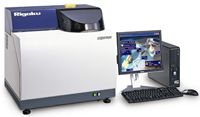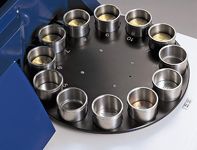Benchtop WDXRF for Cement Analysis
Application Notebook
Cement is one of the most important materials in the construction industry. Traditionally, WDXRF spectrometers used in cement plants have been large, floor-standing models with substantial installation requirements and ownership expenses. This application note demonstrates the capabilities of the Rigaku Supermini - a new low-cost, benchtop wavelength dispersive X-ray fluorescence (WDXRF) spectrometer - for the rapid quantitative elemental analysis of cement raw meal.
Cement is one of the most important materials in the construction industry. Traditionally, WDXRF spectrometers used in cement plants have been large, floor-standing models with substantial installation requirements and ownership expenses. This application note demonstrates the capabilities of the Rigaku Supermini — a new low-cost, benchtop wavelength dispersive X-ray fluorescence (WDXRF) spectrometer — for the rapid quantitative elemental analysis of cement raw meal.
Cement is one of the most important materials in the construction industry. Since its physical properties and those of the concrete ultimately made from it depend on its composition, it is important to monitor the composition of the raw meal used to make the clinker.
Traditionally, WDXRF spectrometers used in cement plants have been large, floor-standing models with substantial installation requirements and ownership expenses. As the industry strives for greater efficiency, operators have increasingly sought equipment that is less expensive to acquire and less costly to maintain. This note demonstrates the capabilities of a low-cost, benchtop WDXRF spectrometer for rapid quantitative elemental analysis of cement raw meal.
Experimental
The pressed-pellet method for powder samples is the most common sample preparation technique in XRF because it does not require an expensive flux, fusion machine, or highly trained operators. For this report, raw meal powders were pulverized and pressed into aluminum rings at 120 kN. Measurements were performed in vacuum, with the X-ray tube operating at full power (50 kV and 4.0 mA) and using the standard crystals: LiF(200), PET, and RX25. The total analysis time for all peak and back-ground lines was about 4 min per sample.

Figure 1: Rigaku Supermini wavelength dispersive X-ray fluorescence (WDXRF).
Results
A series of reference materials of cement raw meal certified by the China State Bureau of Technical Supervision (CSBTS) were used to calibrate the instrument. The calibration results are presented in Table I. One of the reference materials, used in calibration, was measured consecutively 10 times to determine the short-term stability of the method and instrument. These test results are presented in Table II and show that it is possible to analyze pressed pellets of cement raw meal with high repeatability on a 200W WDXRF instrument that is small enough to fit on a bench.

Table II: Repeatability test results (units of wt %)
Conclusion
The Supermini is a sequential WDXRF spectrometer designed specifically to deliver high performance while eliminating typical installation requirements, such as cooling water, special power supply, large floor space, and so on. Featuring a unique air-cooled 200W X-ray tube, two detectors, programmable environment of vacuum or helium, and three analyzing crystals, the Supermini can analyze all relevant elements in just minutes with full spectral separation of all peaks, high sensitivity for light elements and exceptional repeatability. This report demonstrates that cement raw meal samples can be routinely analyzed as pressed powders with excellent accuracy and precision on the Rigaku Supermini low-cost benchtop sequential WDXRF spectrometer.

Figure 2: Rigaku Supermini wavelength dispersive X-ray fluorescence (WDXRF) sample holders.
Rigaku Americas Corp.
9009 New Trails Drive, The Woodlands, TX 77381
tel. (281) 362-2300; Fax: (281) 364-3628
Contact: info@rigaku.com; Website: www.rigaku.com

Thermo Fisher Scientists Highlight the Latest Advances in Process Monitoring with Raman Spectroscopy
April 1st 2025In this exclusive Spectroscopy interview, John Richmond and Tom Dearing of Thermo Fisher Scientific discuss the company’s Raman technology and the latest trends for process monitoring across various applications.
A Seamless Trace Elemental Analysis Prescription for Quality Pharmaceuticals
March 31st 2025Quality assurance and quality control (QA/QC) are essential in pharmaceutical manufacturing to ensure compliance with standards like United States Pharmacopoeia <232> and ICH Q3D, as well as FDA regulations. Reliable and user-friendly testing solutions help QA/QC labs deliver precise trace elemental analyses while meeting throughput demands and data security requirements.